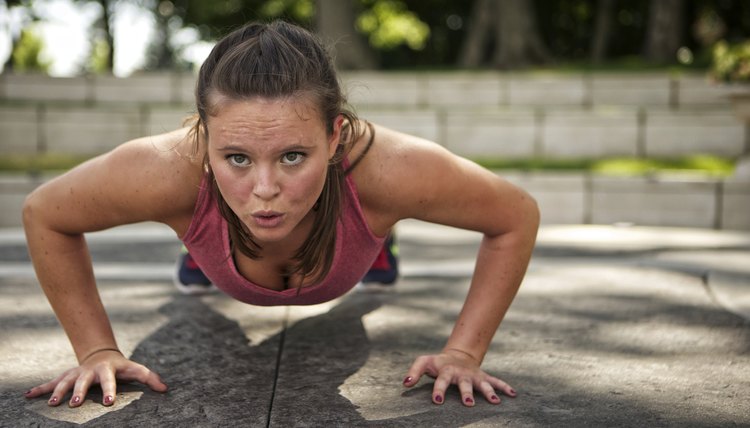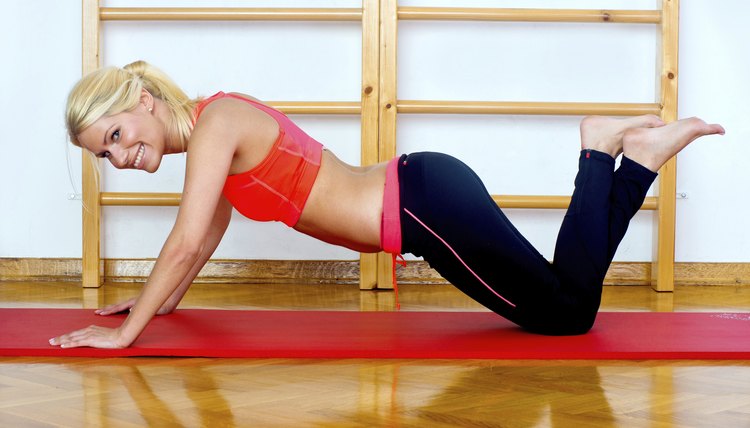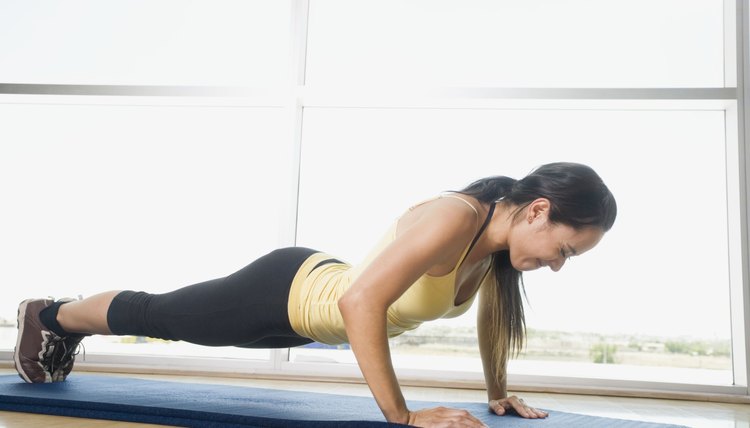How Many Pushups Should a Female Do Per Day?

Push-ups are a basic and extremely effective arm and chest exercise. The number of push-ups a female should perform per day depends upon each woman's level of fitness (strength and endurance) and fitness goals. Your maximum number will be set in part by the time you have to invest, your body's limits and common sense. Rest is an important part of any training program. Most experts agree recovery of 24 to 48 hours is needed to give muscles the opportunity to rebuild.
Beginners

aaron_belford/iStock/Getty Images
If you are just starting to work out or have a very low level of fitness, you should begin slowly until your body acclimates to exercise. Trying to accomplish too much, too soon can lead to an injury and put undue stress and strain on your body.
Beginners should start with modified push-ups, sometimes called girl push-ups, knee push-ups or alternative push-ups. To perform them, place your arms in the traditional push-up position (with your body parallel to the floor and your hands under your shoulders or slightly wider), but instead of fully extending your legs, rest your knees on the floor. Cross your ankles if this is more comfortable. These relieve about half of the load you would lift in a traditional push-up.
Begin with a single set of 10 push-ups. If this is far too easy or you are ready to advance, add sets. Aim to perform two or three sets per session.
Moderately Fit

aaron_belford/iStock/Getty Images
If you are moderately fit, you may begin with either traditional push-ups or knee push-ups, whichever is more comfortable. If you lack upper body strength, you may be able to make faster progress by performing as many traditional push-ups as you can manage (work to failure) and then switching to the easier form to round out your set or increase the number you can accomplish in one session.
Moderately fit women should begin with multiple sets (two to three minimum) of eight to 10 repetitions each.
Fit

aaron_belford/iStock/Getty Images
If you are fit and have at least a moderate level of upper body strength, try moving directly into traditional push-ups. They are tough, and you may have to begin with smaller sets to progress. Start with eight to 10 repetitions. If you can perform them without losing form, increase to a second set. Add sets or add repetitions to increase your count. If you cannot finish a set, drop back into the girl push-up stance to complete that set. Aim for 50 push-ups per session.
As you increase your number of repetitions, you may notice difficulties with your wrists. The weight applied and angle of pressure can be tough on this joint. If you have discomfort or feel strain, try using a set of push-up bars. Push-up bars bring your hands away from the floor. As you grip the bars, your arm enters into a more natural position for movement. The bars allow you to dip lower and protect your wrists from the more extreme angle of a traditional push-up.
Advanced

aaron_belford/iStock/Getty Images
If you possess a large amount of upper body strength or have achieved a higher level of consistent training, you can reach for a maximum number of push-ups or a personal best in your workouts. Fifty to 100 repetitions is considered an advanced number for fit members of either gender.
If you grow bored with your routine, you can move beyond the traditional push-up in order to further test your muscles. Single arm, Hindu and handstand push-ups are extreme versions and should be attempted only by those who have trained well.
Place a medicine ball under one hand for two-handed push-ups that will test your abs and make your chest and arms work harder to retain balance and still lift your weight.
Alternating hand placement is very effective for working out smaller muscle groups and gaining strength in different positions. One example is narrow-grip push-ups. These involve placing the hands slightly forward and together, under the upper chest.
Take extra care when doing more extreme push-ups, as injury is more likely due to the stress on muscles and joints.
References
- One Hundred Push Ups
- The Push-Up Push Workout
- Chest Exercises
- Kim YS, Kim DY, Ha MS. Effect of the push-up exercise at different palmar width on muscle activities. J Phys Ther Sci. 2016;28(2):446-9. doi:10.1589/jpts.28.446
- Calatayud J, Borreani S, Colado JC, et al. Muscle Activation during Push-Ups with Different Suspension Training Systems. J Sports Sci Med. 2014;13(3):502-10.
- Cugliari G, Boccia G. Core Muscle Activation in Suspension Training Exercises. J Hum Kinet. 2017;56:61-71. doi:10.1515/hukin-2017-0023
